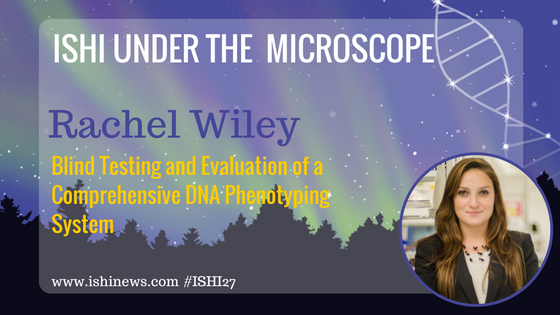The ISHI27 agenda is already filling up with some great talks from amazing speakers! While the forensic community is a tight-knit group, we can always get a little closer, right? With that in mind, we asked our speakers some questions to get to know them a little better outside of their work. We’ve been posting their responses in a feature we like to call Under the Microscope.
Today, we’re chatting with Rachel Wiley, who will be presenting Blind Testing and Evaluation of a Comprehensive DNA Phenotyping System during the General Sessions on Tuesday, September 27th.
Rachel Wiley is a Ph.D. Candidate of Molecular Genetics in Dr. Bruce Budowle’s laboratory at the University of North Texas Health Science Center (UNTHSC) in Fort Worth, TX. She earned her undergraduate degree from the University of North Texas in Biochemistry as well as dual certifications in Forensic Science and Criminalistics. Her undergraduate research concentrated on the application of Direct-Analyte-Probed Nanoextraction (DAPNe) of drug residues in latent fingerprints. She received a Master of Forensic Science in Forensic Molecular Biology from The George Washington University in Washington, DC. Her graduate research focused on evaluating a panel of ancestry informative SNPs for the prediction of an individual’s bioancestry. During her time in Washington DC, she worked as the Forensic/Fraud/Cold Case Intern at the Naval Criminal Investigative Service (NCIS) Washington DC Field Office. Currently, at UNTHSC, her doctoral research centers on establishing new and novel methods for human identification from degraded forensic DNA samples.
How did you come to work in the field of forensics/DNA?
I have always been fascinated by the structure of DNA’s double helix. I want to study all of its mechanisms and applications, more specifically, to the field of forensic science. In it’s intricacies, I believe we can make groundbreaking discoveries and push the field forward.
What is your favorite thing about your job? Why?
My favorite thing about research is exploring the unknown. With research, you almost always never know what is going to be the result. Certainly, there are outcomes that you hope for, but you can never truly know the result until the end. With the unknown, there are no limits and that is what makes research most exciting.
What is the biggest challenge you face in your job?
My favorite thing about my job is also my biggest challenge- searching for answers in the unknown. Usually, a positive outcome is what is needed to succeed and unfortunately, that does not always happen in research. However, at the same time, negative results can and often are essential to drive research forward.
What accomplishment are you most proud of relating to forensics/DNA?
The accomplishments that I am most proud of are being able to work on projects such as the evaluation of Parabon’s Snapshot DNA Phenotyping System and IntegenX’s RapidHIT ID, that have the potential to translate into real-world applications in the field of forensic science and provide a significant impact on the forensics community.
If you’ve attended ISHI before, what keeps you coming back? If you’ve never attended before, what are you most looking forward to at ISHI27?
I have only attended ISHI once and that was ISHI 26. I love the vast array of topics presented and especially the guest speakers. Promega is wonderful at establishing an inviting and creative environment for those in the profession to meet, network, and share ideas.
When you were little, what career did you think you’d have as an adult?
As a child, I was always surrounded by murder mysteries. I wanted to be a detective; however, another great passion of mine had always been science. It was later on that I was introduced to the field of forensic science, the best of both my worlds, and I have never looked back. I knew as soon as I started, this was the career I wanted.
Where do you see the future of forensic science headed?
I see forensic science progressing forward rapidly. With the advent of modern technology and the forward thinking to capitalize on the progression of that technology, I see no limits to what forensic science can accomplish.
What do you hope the audience learns/takes away from your talk?
I hope what the audience will take away from my talk is an understanding of where forensic science is today as well as its growing complexity and utilization. The Parabon Snapshot DNA Phenotyping system is an example of the novel scientific techniques becoming available to forensics today.
What person would you say has had the biggest influence in your career?
My father and Sherlock Holmes. The only genre that my Dad has ever read was murder-mysteries; therefore, those were the only books essentially in the house. While growing up, I was constantly surrounded by the “father of forensics” and the “who-done-its.” I highly attribute my love for forensics to the mysteries investigated by Holmes and my Dad for their introduction into my life.
If you could time-travel, what year would you go to and why?
If I could time-travel, I would travel into the future. With what science has been able to discover and achieve in only the past century is incredible. It is fascinating to think about what has yet to be created.
Star Wars or Star Trek?
Star Wars.
WOULD YOU LIKE TO SEE MORE ARTICLES LIKE THIS? SUBSCRIBE TO THE ISHI BLOG BELOW!
SUBSCRIBE NOW!
[divider]


